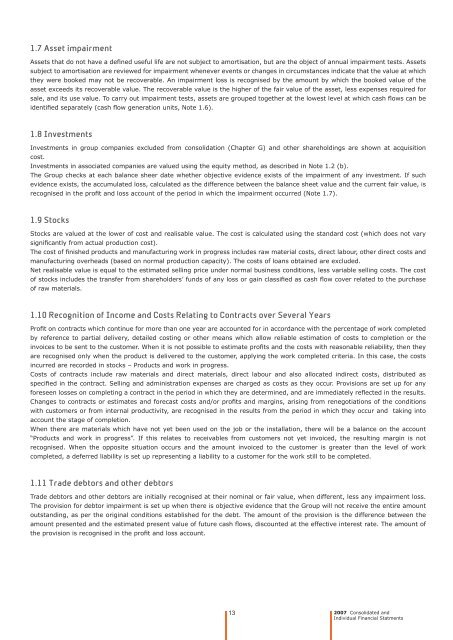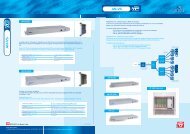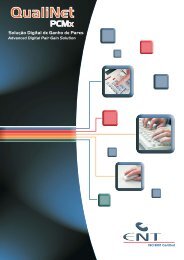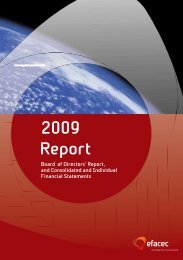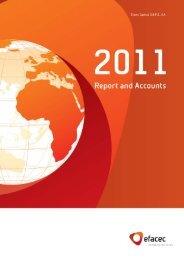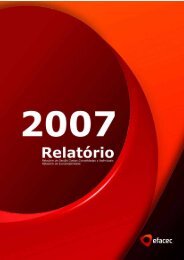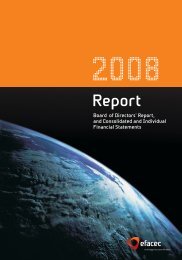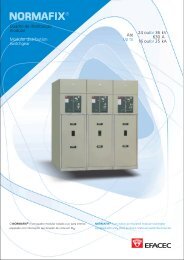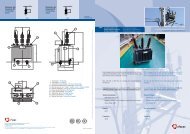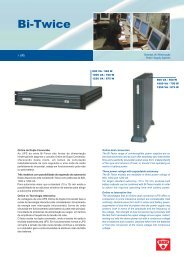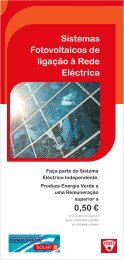Notes to the Financial Statements - Efacec
Notes to the Financial Statements - Efacec
Notes to the Financial Statements - Efacec
Create successful ePaper yourself
Turn your PDF publications into a flip-book with our unique Google optimized e-Paper software.
1.7 Asset impairment<br />
Assets that do not have a defi ned useful life are not subject <strong>to</strong> amortisation, but are <strong>the</strong> object of annual impairment tests. Assets<br />
subject <strong>to</strong> amortisation are reviewed for impairment whenever events or changes in circumstances indicate that <strong>the</strong> value at which<br />
<strong>the</strong>y were booked may not be recoverable. An impairment loss is recognised by <strong>the</strong> amount by which <strong>the</strong> booked value of <strong>the</strong><br />
asset exceeds its recoverable value. The recoverable value is <strong>the</strong> higher of <strong>the</strong> fair value of <strong>the</strong> asset, less expenses required for<br />
sale, and its use value. To carry out impairment tests, assets are grouped <strong>to</strong>ge<strong>the</strong>r at <strong>the</strong> lowest level at which cash fl ows can be<br />
identifi ed separately (cash fl ow generation units, Note 1.6).<br />
1.8 Investments<br />
Investments in group companies excluded from consolidation (Chapter G) and o<strong>the</strong>r shareholdings are shown at acquisition<br />
cost.<br />
Investments in associated companies are valued using <strong>the</strong> equity method, as described in Note 1.2 (b).<br />
The Group checks at each balance sheer date whe<strong>the</strong>r objective evidence exists of <strong>the</strong> impairment of any investment. If such<br />
evidence exists, <strong>the</strong> accumulated loss, calculated as <strong>the</strong> difference between <strong>the</strong> balance sheet value and <strong>the</strong> current fair value, is<br />
recognised in <strong>the</strong> profi t and loss account of <strong>the</strong> period in which <strong>the</strong> impairment occurred (Note 1.7).<br />
1.9 S<strong>to</strong>cks<br />
S<strong>to</strong>cks are valued at <strong>the</strong> lower of cost and realisable value. The cost is calculated using <strong>the</strong> standard cost (which does not vary<br />
signifi cantly from actual production cost).<br />
The cost of fi nished products and manufacturing work in progress includes raw material costs, direct labour, o<strong>the</strong>r direct costs and<br />
manufacturing overheads (based on normal production capacity). The costs of loans obtained are excluded.<br />
Net realisable value is equal <strong>to</strong> <strong>the</strong> estimated selling price under normal business conditions, less variable selling costs. The cost<br />
of s<strong>to</strong>cks includes <strong>the</strong> transfer from shareholders’ funds of any loss or gain classifi ed as cash fl ow cover related <strong>to</strong> <strong>the</strong> purchase<br />
of raw materials.<br />
1.10 Recognition of Income and Costs Relating <strong>to</strong> Contracts over Several Years<br />
Profi t on contracts which continue for more than one year are accounted for in accordance with <strong>the</strong> percentage of work completed<br />
by reference <strong>to</strong> partial delivery, detailed costing or o<strong>the</strong>r means which allow reliable estimation of costs <strong>to</strong> completion or <strong>the</strong><br />
invoices <strong>to</strong> be sent <strong>to</strong> <strong>the</strong> cus<strong>to</strong>mer. When it is not possible <strong>to</strong> estimate profi ts and <strong>the</strong> costs with reasonable reliability, <strong>the</strong>n <strong>the</strong>y<br />
are recognised only when <strong>the</strong> product is delivered <strong>to</strong> <strong>the</strong> cus<strong>to</strong>mer, applying <strong>the</strong> work completed criteria. In this case, <strong>the</strong> costs<br />
incurred are recorded in s<strong>to</strong>cks – Products and work in progress.<br />
Costs of contracts include raw materials and direct materials, direct labour and also allocated indirect costs, distributed as<br />
specifi ed in <strong>the</strong> contract. Selling and administration expenses are charged as costs as <strong>the</strong>y occur. Provisions are set up for any<br />
foreseen losses on completing a contract in <strong>the</strong> period in which <strong>the</strong>y are determined, and are immediately refl ected in <strong>the</strong> results.<br />
Changes <strong>to</strong> contracts or estimates and forecast costs and/or profi ts and margins, arising from renegotiations of <strong>the</strong> conditions<br />
with cus<strong>to</strong>mers or from internal productivity, are recognised in <strong>the</strong> results from <strong>the</strong> period in which <strong>the</strong>y occur and taking in<strong>to</strong><br />
account <strong>the</strong> stage of completion.<br />
When <strong>the</strong>re are materials which have not yet been used on <strong>the</strong> job or <strong>the</strong> installation, <strong>the</strong>re will be a balance on <strong>the</strong> account<br />
“Products and work in progress”. If this relates <strong>to</strong> receivables from cus<strong>to</strong>mers not yet invoiced, <strong>the</strong> resulting margin is not<br />
recognised. When <strong>the</strong> opposite situation occurs and <strong>the</strong> amount invoiced <strong>to</strong> <strong>the</strong> cus<strong>to</strong>mer is greater than <strong>the</strong> level of work<br />
completed, a deferred liability is set up representing a liability <strong>to</strong> a cus<strong>to</strong>mer for <strong>the</strong> work still <strong>to</strong> be completed.<br />
1.11 Trade deb<strong>to</strong>rs and o<strong>the</strong>r deb<strong>to</strong>rs<br />
Trade deb<strong>to</strong>rs and o<strong>the</strong>r deb<strong>to</strong>rs are initially recognised at <strong>the</strong>ir nominal or fair value, when different, less any impairment loss.<br />
The provision for deb<strong>to</strong>r impairment is set up when <strong>the</strong>re is objective evidence that <strong>the</strong> Group will not receive <strong>the</strong> entire amount<br />
outstanding, as per <strong>the</strong> original conditions established for <strong>the</strong> debt. The amount of <strong>the</strong> provision is <strong>the</strong> difference between <strong>the</strong><br />
amount presented and <strong>the</strong> estimated present value of future cash fl ows, discounted at <strong>the</strong> effective interest rate. The amount of<br />
<strong>the</strong> provision is recognised in <strong>the</strong> profi t and loss account.<br />
13<br />
2007 Consolidated and<br />
Individual <strong>Financial</strong> Statments


